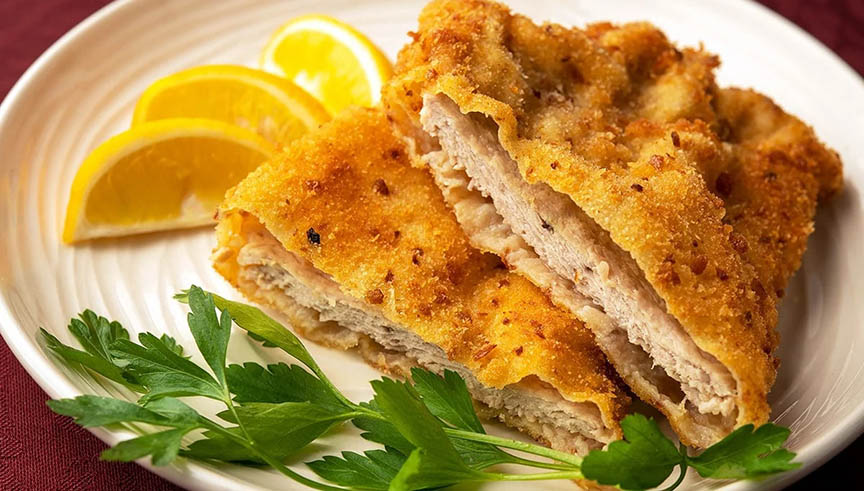
A Culinary Journey Through Austria: Experience Traditional Viennese Schnitzel and Desserts
Austria, located at the heart of Europe, is renowned not only for its breathtaking Alpine landscapes and rich historical heritage but also for its extraordinary culinary traditions. As the capital of Austria, Vienna stands as the ultimate destination to explore Austrian cuisine. In this elegant and romantic city, you can indulge in the world-famous Wiener Schnitzel, along with a variety of traditional desserts such as Sachertorte and Kaiserschmarrn.
I will take you on a gastronomic journey through Austria, delving into the history of Viennese schnitzel, recommending the best restaurants to try it, and exploring the irresistible charm of Viennese desserts. Additionally, I will share some must-experience culinary activities.
I. Viennese Schnitzel: Austria’s National Dish
1. The History and Tradition of Wiener Schnitzel
Wiener Schnitzel is one of Austria’s most iconic dishes, with its origins tracing back to the 19th century. It is believed that this dish was inspired by the “Cotoletta alla Milanese”, a breaded veal cutlet from Milan, Italy. During military campaigns in Italy, Austrian Field Marshal Joseph Radetzky encountered this delicacy and brought the recipe back to Austria. Over time, the dish evolved in Vienna, becoming the classic Wiener Schnitzel we know today.
Traditional Wiener Schnitzel is carefully prepared with specific techniques to ensure its authentic taste and texture. The key steps in making an authentic Wiener Schnitzel include:
- Selecting the Meat – The best Wiener Schnitzel is made from veal, specifically the tenderloin, which provides a fine texture and delicate flavor.
- Pounding the Meat – The veal is gently pounded until it is about 4mm thick, ensuring an even and tender consistency.
- Three-Step Breading – The meat is coated in flour, dipped in beaten eggs, and finally covered in breadcrumbs. Traditional Austrian breadcrumbs (Semmelbrösel) are used to achieve the perfect crispy crust.
- Frying Technique – The schnitzel is deep-fried in clarified butter (Butterschmalz) or vegetable oil until it turns a golden-brown color. During frying, the pan is gently shaken to ensure the breading puffs up and fries evenly.
- Classic Accompaniments – Wiener Schnitzel is traditionally served with potato salad (Erdäpfelsalat), cucumber salad (Gurkensalat), and a slice of lemon to add a refreshing balance to the dish.
While many restaurants offer variations made with pork, chicken, or turkey, according to Austrian food regulations, only schnitzel made from veal can officially be called “Wiener Schnitzel”. Any other versions must specify the type of meat used, such as “Wiener Schnitzel vom Schwein” (pork schnitzel).
2. Best Restaurants for Wiener Schnitzel in Vienna
Vienna is home to numerous restaurants that serve authentic Wiener Schnitzel, ranging from historic taverns to modern establishments. Here are some of the most highly recommended places to try this Austrian specialty:
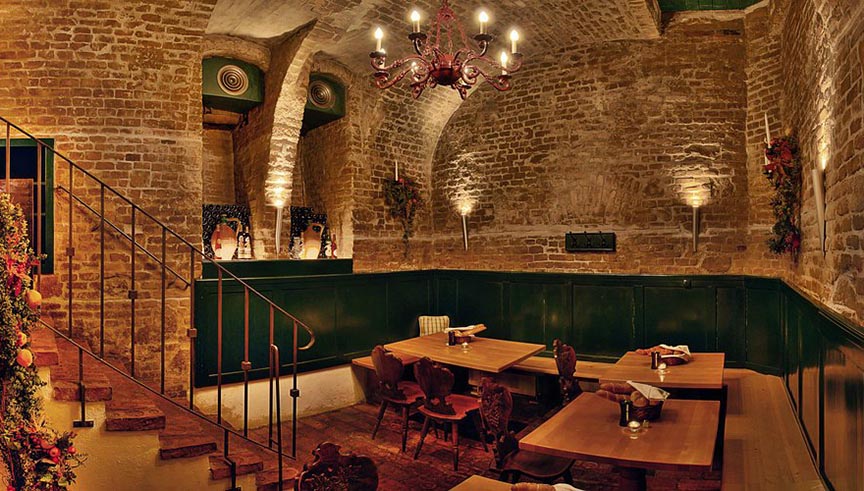
① Figlmüller – “The Home of the Schnitzel”
Address: Wollzeile 5, 1010 Vienna, Austria
Opening Hours: Daily, 11:00 AM – 10:30 PM
Why Visit?
- Founded in 1905, this restaurant is widely known as the “Home of the Schnitzel”, making it a must-visit spot for schnitzel lovers.
- Figlmüller’s schnitzel is famous for its enormous size, often covering the entire plate. It is crispy, golden, and served with their signature potato salad.
- Their handmade sweet-and-sour dressing adds a delightful contrast to the rich flavors of the schnitzel.
② Plachutta Wollzeile – A Temple of Austrian Cuisine
Address: Wollzeile 38, 1010 Vienna, Austria
Opening Hours: Daily, 11:30 AM – Midnight
Why Visit?
- Plachutta is famous not only for Wiener Schnitzel but also for another Austrian classic, Tafelspitz (boiled beef dish).
- They use high-quality veal, fried to perfection and served with traditional potato salad and pickles.
③ Gasthaus Pöschl – A Cozy Traditional Tavern
Address: Weihburggasse 17, 1010 Vienna, Austria
Opening Hours: 12:00 PM – 10:30 PM (Closed on Sundays)
Why Visit?
- A favorite among locals, this charming gastropub serves authentic Austrian cuisine in a cozy and welcoming atmosphere.
- Their schnitzel is made using organic veal from local farms, paired with homemade potato salad.
II. Viennese Desserts: Austria’s Sweet Temptations
Vienna is not only famous for its delicious schnitzels but also for a wide range of classic desserts that every sweet tooth must try! The city’s dessert culture is deeply rooted in its rich history, with each delicacy not only being a delight to the taste buds but also carrying the elegance of the imperial era and the craftsmanship of Austrian pastry-making. Strolling through the streets of Vienna, you’ll discover numerous historic cafés, each offering unique desserts and beverages that will leave you enchanted.
1. Classic Dessert Recommendations
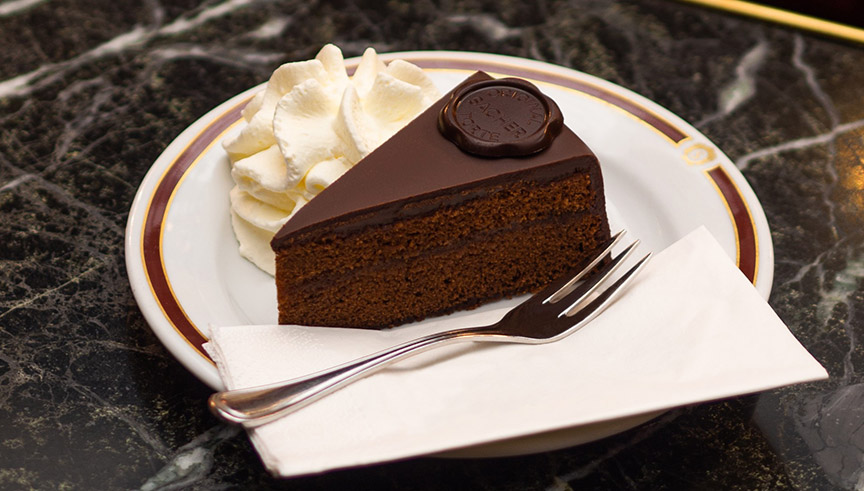
① Sachertorte – The Most Famous Chocolate Cake in the World
Sachertorte is one of the world’s most renowned chocolate cakes, symbolizing Austria’s baking tradition and aristocratic heritage. This iconic cake was created in 1832 by Austrian pastry chef Franz Sacher for the Austrian statesman Klemens Wenzel von Metternich. Since then, it has become one of Vienna’s most representative desserts.
Features and Preparation of Sachertorte
The uniqueness of Sachertorte lies in the perfect balance between rich chocolate and fruity apricot jam. The traditional Sachertorte consists of the following key components:
- Chocolate Cake Base: Made with high-quality cocoa powder, the cake is dense and delicate, with a slightly bitter chocolate flavor.
- Apricot Jam Layer: A thin layer of apricot jam is spread between the cake layers, adding a hint of fruity sweetness while keeping the cake moist.
- Chocolate Glaze: The cake is coated with a thick layer of dark chocolate glaze, giving it a rich chocolate taste and a glossy appearance.
- Served with Whipped Cream (Schlagobers): Traditionally, Sachertorte is accompanied by a portion of freshly whipped unsweetened cream to balance the intense chocolate flavor.
This classic dessert is still made following the original secret recipe and is protected as a trademark by the Sacher family. If you want to taste an authentic Sachertorte in Vienna, the best places to visit are:
Best Places to Try Sachertorte
- Café Sacher (Philharmoniker Str. 4, 1010 Wien, Austria)
- Located inside Hotel Sacher, this is the best place to enjoy the authentic Sachertorte. The cake here is still made according to the 19th-century secret recipe, offering a rich and indulgent experience.
- The café’s vintage decor, red velvet seating, and crystal chandeliers create an elegant atmosphere, making it a must-visit for those who want to immerse themselves in Vienna’s café culture.
- Demel (Kohlmarkt 14, 1010 Wien, Austria)
- Another historic café that once served as the official pastry supplier to the Habsburg royal family.
- Demel and Café Sacher were involved in a legal dispute over the rights to the “Original Sachertorte.” In the end, both cafés were allowed to produce Sachertorte, but Demel’s version has a slightly different jam layer and texture.
- Demel’s elegant interior and wide range of Austrian pastries make it a paradise for dessert lovers.
② Kaiserschmarrn – The Emperor’s Favorite Pancake
Kaiserschmarrn is a fluffy, caramelized pancake that is torn into bite-sized pieces, dusted with powdered sugar, and traditionally served with stewed plums (Zwetschgenröster) or applesauce (Apfelmus). This dessert was named “Emperor’s Pancake” because it was a beloved dish of Austrian Emperor Franz Joseph I.
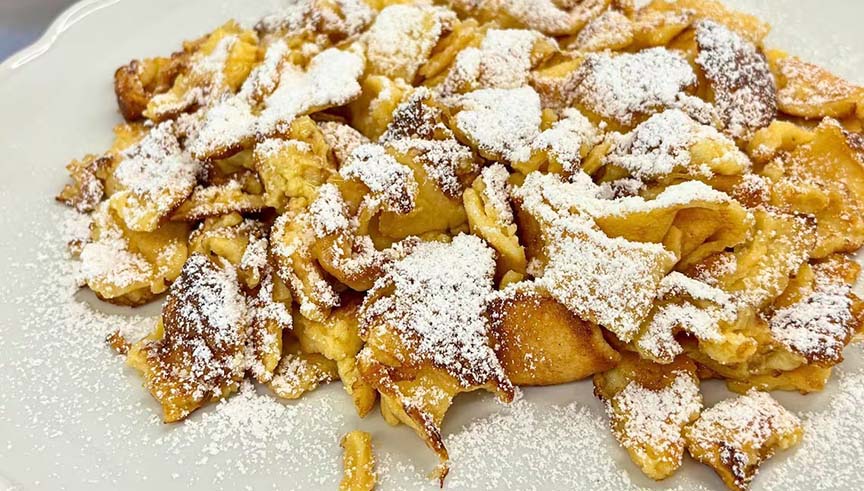
Features and Preparation of Kaiserschmarrn
Unlike regular pancakes, Kaiserschmarrn is more like a light and airy soufflé. The preparation method involves whipping egg yolks and egg whites separately to achieve a fluffy texture. It has a consistency between a French crêpe and an American pancake, with a caramelized exterior that adds a subtle crunch. The key characteristics of Kaiserschmarrn include:
- Soft, eggy texture: Made with a generous amount of eggs, milk, and flour, creating a light and airy pancake.
- Caramelized surface: Sugar is sprinkled on top while cooking, allowing it to caramelize and form a thin, crisp layer.
- Traditional fruit accompaniments: Austrians love pairing it with stewed plums or applesauce, as the tartness helps balance the sweetness.
- Served in bite-sized pieces: Instead of being served whole, Kaiserschmarrn is torn into irregular pieces before being plated, giving it a casual yet irresistible look.
The Legend Behind Kaiserschmarrn
There is an interesting story about the origin of Kaiserschmarrn. According to legend, this dessert was originally created for Empress Elisabeth (Sisi), who was known for her preference for light and healthy meals. However, she found this dish too rich and sweet, so it was given to Emperor Franz Joseph instead. The emperor loved it so much that it became a staple dessert in the imperial household, hence the name “Kaiserschmarrn” (Emperor’s Pancake).
Best Places to Try Kaiserschmarrn
- Café Central (Herrengasse 14, 1010 Wien, Austria)
- One of Vienna’s most famous literary cafés, once frequented by Sigmund Freud, Lenin, and Stefan Zweig.
- Their Kaiserschmarrn is exceptionally well-made, with a light and fluffy texture, served with sweet stewed plums, making it an ideal choice for an afternoon treat.
- The café’s grand architecture, high ceilings, marble columns, and elegant chandeliers make it a fantastic place to enjoy a royal-like dining experience.
Viennese Desserts – A Cultural Experience
In Vienna, desserts are not just food; they are an essential part of the city’s cultural heritage. From the rich and decadent Sachertorte to the light and airy Kaiserschmarrn, every dessert tells a story of history, craftsmanship, and imperial elegance.
If you visit Vienna, be sure to step into a century-old café, order a classic dessert, and pair it with a cup of traditional Viennese coffee. Let the romance and sweetness of this city unfold on your palate as you indulge in its legendary treats.
You May Also Like

Red Rock Park: Spectacular Rock Formations and Outdoor Adventures
26/08/2023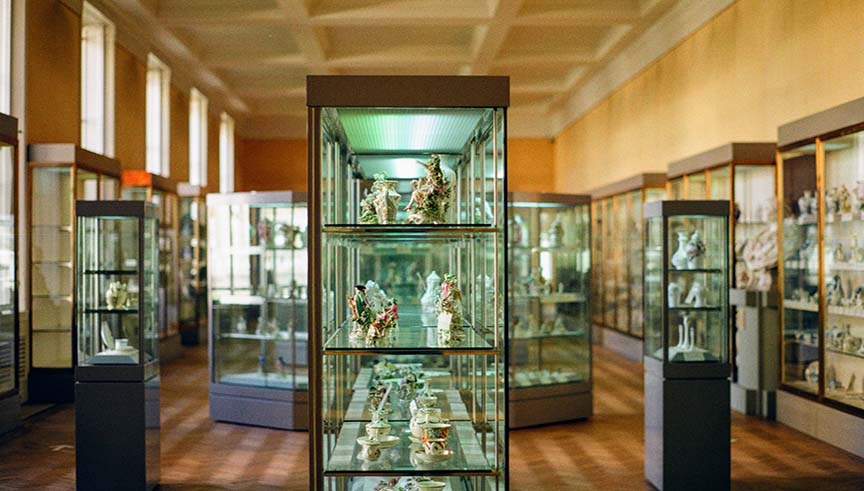
Cambridge’s Art and History: Must-Visit Museums
29/10/2023

